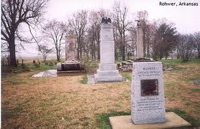Student Grant to Restore Rohwer Site
UALR graduate student Tamisha Cheatham has secured a $250,000 grant from the National Park Services to help restore the cemetery at the Rohwer Japanese American Internment Camp in Desha County in southeastern Arkansas.
 Cheatham, who is seeking a master of public history degree, wrote the grant for the Japanese-American Confinement Sites program.
Cheatham, who is seeking a master of public history degree, wrote the grant for the Japanese-American Confinement Sites program.
“The cemetery at Rohwer is only one of three Japanese-American internment camps cemeteries in existence,” she said. “The funding will be used to stabilize and restore the cemetery’s historic structures including monuments, headstones, and flower holders.”
The Rohwer Internment Camp, in operation from September 1942 to November 1945, was one of two relocation centers in the state to house Japanese-Americans from the west coast during World War II. The attack on Pearl Harbor on Dec. 7, 1941, fomented fears that the U.S. could be vulnerable to an invasion by the Japanese empire through the American west coast where 89 percent of Japanese-Americans lived.
Due to rising anti-Japanese sentiment, President Franklin D. Roosevelt, under the doctrine of “military necessity,” signed an executive order to create the War Relocation Act.
Subsequently, 10 relocation camps were constructed in the U.S. More than 16,000 Japanese-Americans were housed in Rohwer and the other internment camp in Arkansas, the Jerome Relocation Center in Chicot and Drew counties.
“I chose this particular project not only because of the compelling subject matter, but because it afforded me the opportunity to get real-world experience in historic preservation and grant writing processes,” Cheatham said. “The Japanese-American cemetery at Rohwer and other Japanese-American internment sites across the nation represent a painful episode in this nation’s past. I believe preservation of these 10 sites is an important step forward in the healing process.”
Rohwer consisted of 500 gridded acres of wood-framed barracks with tar paper roofs. In addition to living quarters and communal eating and bathing facilities, the camp housed a hospital, a fire station, schools, and recreation halls. The camp newspaper, the Rohwer Outpost, was staffed by the internees.
“The camp was a city unto itself,” Cheatham said. “The peak population at Rohwer was 8,475.”
Two historic monuments are located inside the Rohwer camp – the Monument to the Rohwer Dead and the Monument to the Men of the 100th Battalion, 44th Regimental Combat Team. The 28 grave markers in the cemetery were for infants and individuals who did not have families.
Johanna Miller-Lewis, professor of history and associate dean of the graduate school, directs the UALR Rohwer project.
“That cemetery is the most powerful argument against government disrespecting U.S. citizens’ civil liberties,” said Lewis. “The fact that it has been allowed to fall in to decay is a tragedy.”
In 2004, UALR led “Life Interrupted,” a wide-scoping project throughout Little Rock that revealed the experiences of internees at Rohwer through art exhibitions, the PBS documentary “Time of Fear,” and a symposium at the Peabody Hotel that included survivors of the relocation camp. One of the survivors who spoke at the symposium was actor George Takei, best known for his portrayal of Mr. Sulu in the original “Star Trek” television series.
Many of the artifacts and documents from “Life Interrupted” are housed in the UALR Center for History and Culture at the Arkansas Studies Institute in downtown Little Rock.
“‘Life Interrupted’ was a $4 million grant-funded project between the UALR Public History program and the Japanese-American National Museum in Los Angeles, California,” said Lewis. “This new grant from the National Park Services will allow us to continue the ‘Life Interrupted’ project. We did not get to address the conservation needs of the cemetery in 2004. Hopefully, we’ll receive more funding in the future for more conservation and landscaping. The whole approach to Rohwer has changed in this way.”
Currently, the exhibition, “The Art of Living,” is on display at the Butler Center in the Arkansas Studies Institute. The show includes artwork created by internees during their time at Rowher.
For more information about the restoration efforts at Rowher, contact Lewis at 501-569-8661 or at jmlewis@ualr.edu.